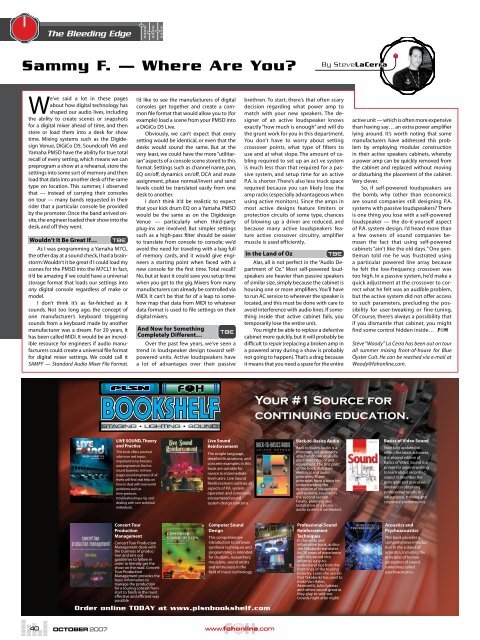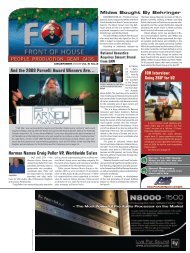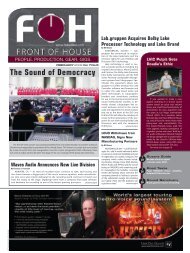You also want an ePaper? Increase the reach of your titles
YUMPU automatically turns print PDFs into web optimized ePapers that Google loves.
40<br />
The Bleeding Anklebiters Edge<br />
Sammy F. — Where Are You?<br />
We’ve said a lot in these pages<br />
about how digital technology has<br />
shaped our audio lives, including<br />
the ability to create scenes or snapshots<br />
for a digital mixer ahead of time, and then<br />
store or load them into a desk for show<br />
time. Mixing systems such as the Digidesign<br />
Venue, DiGiCo D5, Soundcraft Vi6 and<br />
Yamaha PM5D have the ability for true total<br />
recall of every setting, which means we can<br />
preprogram a show at a rehearsal, store the<br />
settings into some sort of memory and then<br />
load that data into another desk of the same<br />
type on location. This summer, I observed<br />
that — instead of carrying their consoles<br />
on tour — many bands requested in their<br />
rider that a particular console be provided<br />
by the promoter. Once the band arrived onsite,<br />
the engineer loaded their show into the<br />
desk, and off they went.<br />
Wouldn’t It Be Great If… TBE<br />
As I was programming a Yamaha M7CL<br />
the other day at a sound check, I had a brainstorm:<br />
Wouldn’t it be great if I could load my<br />
scenes for the PM5D into the M7CL? In fact,<br />
it’d be amazing if we could have a universal<br />
storage format that loads our settings into<br />
any digital console regardless of make or<br />
model.<br />
I don’t think it’s as far-fetched as it<br />
sounds. Not too long ago, the concept of<br />
one manufacturer’s keyboard triggering<br />
sounds from a keyboard made by another<br />
manufacturer was a dream. For 20 years, it<br />
has been called MIDI. It would be an incredible<br />
resource for engineers if audio manufacturers<br />
could create a universal file format<br />
for digital mixer settings. We could call it<br />
SAMFF — Standard Audio Mixer File Format.<br />
OCTOBER 2007<br />
I’d like to see the manufacturers of digital<br />
consoles get together and create a common<br />
file format that would allow you to (for<br />
example) load a scene from your PM5D into<br />
a DiGiCo D5 Live.<br />
Obviously, we can’t expect that every<br />
setting would be identical, or even that the<br />
desks would sound the same. But at the<br />
very least, we could have the more “utilitarian”<br />
aspects of a console scene stored to this<br />
format. Settings such as channel name, pan,<br />
EQ on/off, dynamics on/off, DCA and mute<br />
assignment, phase normal/invert and send<br />
levels could be translated easily from one<br />
desk to another.<br />
I don’t think it’d be realistic to expect<br />
that your kick drum EQ on a Yamaha PM5D<br />
would be the same as on the Digidesign<br />
Venue — particularly when third-party<br />
plug-ins are involved. But simpler settings<br />
such as a high-pass filter should be easier<br />
to translate from console to console; we’d<br />
avoid the need for traveling with a bag full<br />
of memory cards, and it would give engineers<br />
a starting point when faced with a<br />
new console for the first time. Total recall?<br />
No, but at least it could save you setup time<br />
when you get to the gig. Mixers from many<br />
manufacturers can already be controlled via<br />
MIDI. It can’t be that far of a leap to somehow<br />
map that data from MIDI to whatever<br />
data format is used to file settings on their<br />
digital mixers.<br />
And Now for Something<br />
Completely Different…<br />
TBE<br />
Over the past few years, we’ve seen a<br />
trend in loudspeaker design toward selfpowered<br />
units. Active loudspeakers have<br />
a lot of advantages over their passive<br />
STAGING • LIGHTING • SOUND<br />
LIVE SOUND, Theory<br />
and Practice<br />
This book oers practical<br />
advice on real topics<br />
important to technicians<br />
and engineers in the live<br />
sound business. In these<br />
pages sound engineers of all<br />
levels will nd vital help on<br />
how to deal with real-world<br />
problems such as<br />
time-pressure,<br />
troubleshooting a rig and<br />
dealing with non-technical<br />
individuals.<br />
Concert Tour<br />
Production<br />
Management<br />
Concert Tour Production<br />
Management deals with<br />
the business of production<br />
and sets out<br />
guidelines to follow in<br />
order to literally get the<br />
show on the road. Concert<br />
Tour Production<br />
Management provides the<br />
basic information to<br />
manage the production<br />
for a touring concert from<br />
start to nish in the most<br />
eective and ecient way<br />
possible.<br />
Live Sound<br />
Reinforcement<br />
The simple language,<br />
detailed illustrations, and<br />
concrete examples in this<br />
book are suitable for<br />
novice to intermediatelevel<br />
users. Live Sound<br />
Reinforcement outlines all<br />
aspects of P.A. system<br />
operation and commonly<br />
encountered sound<br />
system design concerns.<br />
Computer Sound<br />
Design<br />
This comprehensive<br />
introduction to software<br />
synthesis techniques and<br />
programming is intended<br />
for students, researchers,<br />
musicians, sound artists<br />
and enthusiasts in the<br />
eld of music technology.<br />
Order online TODAY at www.plsnbookshelf.com<br />
www.fohonline.com<br />
brethren. To start, there’s that often scary<br />
decision regarding what power amp to<br />
match with your new speakers. The designer<br />
of an active loudspeaker knows<br />
exactly “how much is enough” and will do<br />
the grunt work for you in this department.<br />
You don’t have to worry about setting<br />
crossover points, what type of filters to<br />
use and at what slope. The amount of cabling<br />
required to set up an act ve system<br />
is much less than that required for a passive<br />
system, and setup time for an active<br />
P.A. is shorter. There’s also less truck space<br />
required because you can likely lose the<br />
amp racks (especially advantageous when<br />
using active monitors). Since the amps in<br />
most active designs feature limiters or<br />
protection circuits of some type, chances<br />
of blowing up a driver are reduced, and<br />
because many active loudspeakers feature<br />
active crossover circuitry, amplifier<br />
muscle is used efficiently.<br />
In the Land of Oz TBE<br />
Alas, all is not perfect in the “Audio Department<br />
of Oz.” Most self-powered loudspeakers<br />
are heavier than passive speakers<br />
of similar size, simply because the cabinet is<br />
housing one or more amplifiers. You’ll have<br />
to run AC service to wherever the speaker is<br />
located, and this must be done with care to<br />
avoid interference with audio lines. If something<br />
inside that active cabinet fails, you<br />
temporarily lose the entire unit.<br />
You might be able to replace a defective<br />
cabinet more quickly, but it will probably be<br />
difficult to repair (replacing a broken amp in<br />
a powered array during a show is probably<br />
not going to happen). That’s a drag because<br />
it means that you need a spare for the entire<br />
By SteveLaCerra<br />
active unit — which is often more expensive<br />
than having say… an extra power amplifier<br />
lying around. It’s worth noting that some<br />
manufacturers have addressed this problem<br />
by employing modular construction<br />
in their active speakers cabinets, whereby<br />
a power amp can be quickly removed from<br />
the cabinet and replaced without moving<br />
or disturbing the placement of the cabinet.<br />
Very clever.<br />
So, if self-powered loudspeakers are<br />
the bomb, why (other than economics)<br />
are sound companies still designing P.A.<br />
systems with passive loudspeakers? There<br />
is one thing you lose with a self-powered<br />
loudspeaker — the do-it-yourself aspect<br />
of P.A. system design. I’d heard more than<br />
a few owners of sound companies bemoan<br />
the fact that using self-powered<br />
cabinets “ain’t like the old days.” One gentleman<br />
told me he was frustrated using<br />
a particular powered line array because<br />
he felt the low-frequency crossover was<br />
too high. In a passive system, he’d make a<br />
quick adjustment at the crossover to correct<br />
what he felt was an audible problem,<br />
but the active system did not offer access<br />
to such parameters, precluding the possibility<br />
for user-tweaking or fine-tuning.<br />
Of course, there’s always a possibility that<br />
if you dismantle that cabinet, you might<br />
find some control hidden inside… .<br />
Steve “Woody” La Cerra has been out on tour<br />
all summer mixing front-of-house for Blue<br />
Öyster Cult. He can be reached via e-mail at<br />
Woody@fohonline.com.<br />
Your #1 Source for<br />
continuing education.<br />
Back-to-Basics Audio<br />
Back to Basics Audio is a<br />
thorough, yet approachable<br />
handbook on audio<br />
electronics theory and<br />
equipment. The rst part<br />
of the book discusses<br />
electrical and audio<br />
principles. Those<br />
principles form a basis for<br />
understanding the<br />
operation of equipment<br />
and systems, covered in<br />
the second section.<br />
Finally, planning and<br />
installation of a home<br />
audio system is addressed.<br />
Professional Sound<br />
Reinforcement<br />
Techniques<br />
In this witty and<br />
informative book, author<br />
Jim Yakabuski translates<br />
his 20 years of experience<br />
with live sound into<br />
informal, easy-tounderstand<br />
tips from the<br />
front lines of the touring<br />
industry. Learn the secrets<br />
that Yakabuski has used to<br />
make Van Halen,<br />
Aerosmith, Julio Iglesias<br />
and others sound great as<br />
they play to sold-out<br />
crowds night after night!<br />
Basics of Video Sound<br />
Now fully updated to<br />
reect the latest advances,<br />
the second edition of<br />
Basics of Video Sound is a<br />
primer for anyone wishing<br />
to learn about recording<br />
sound. It describes the<br />
principles and processes<br />
involved in obtaining<br />
professional results in<br />
educational, training and<br />
corporate environments.<br />
Acoustics and<br />
Psychoacoustics<br />
This book provides a<br />
comprehensive introduction<br />
to the subject of<br />
acoustics, including the<br />
principles of human<br />
perception of sound,<br />
sometimes called<br />
psychoacoustics.
















